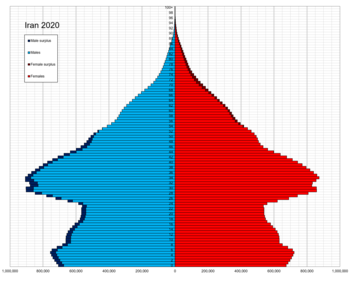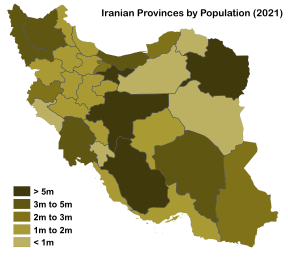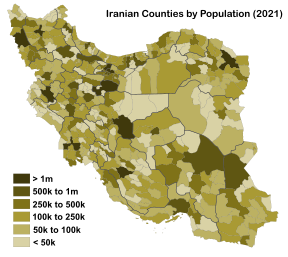
Back سكان إيران Arabic İran əhalisi Azerbaijani Население на Иран Bulgarian ইরানের জনপরিসংখ্যান Bengali/Bangla Demografiya İrani DIQ Demografía de Irán Spanish جمعیتشناسی ایران Persian Démographie de l'Iran French דמוגרפיה של איראן HE ईरान की जनसांख्यिकी Hindi
| Demographics of Iran | |
|---|---|
 Population pyramid of Iran in 2020 | |
| Population | 91,866,747 (November 2024 est.) |
| Density | 54.509511/km2 |
| Growth rate | 0.98% (2022 est.) |
| Birth rate | 15.27 births/1,000 population (2022 est.) |
| Death rate | 5.17 deaths/1,000 population (2022 est.) |
| Life expectancy | 75.25 years |
| • male | 73.89 years |
| • female | 76.67 years |
| Fertility rate | 1.66 children born/woman (2023 official) |
| Infant mortality rate | 14.84 deaths/1,000 live births |
| Net migration rate | −0.3 migrant(s)/1,000 population (2022 est.) |
| Age structure | |
| 0–14 years | 23.3% |
| 15–64 years | 69.8% |
| 65 and over | 7% (2024 est.) |
| Sex ratio | |
| Total | 1.03 male(s)/female (2022 est.) |
| At birth | 1.05 male(s)/female |
| Under 15 | 1.05 male(s)/female |
| 15–64 years | 1.03 male(s)/female |
| 65 and over | 0.77 male(s)/female |
| Nationality | |
| Nationality | Iranian |
| Major ethnic | Persians |
| Minor ethnic | |
| Language | |
| Official | Persian |
| Spoken | Languages of Iran |

Iran's population increased dramatically during the later half of the 20th century, reaching about 80 million by 2016.[1][2] As of November 2024[update], Iran's population is around 91.5 million.[3] In recent years, however, Iran's birth rate has dropped significantly. Studies project that Iran's rate of population growth will continue to slow until it stabilises above 100 million by 2050.[4][5] Half of Iran's population was under 35 years old in 2012.[6] As of January 2025, the average age of the Iranian population is 32 years.[7]
In 2009, the number of households stood at 15.3 million (4.8 persons per household).[8] Families earn some 11.8 million rials (about $960) per month on average (2012).[9]
According to the OECD/World Bank statistics population growth in Iran from 1990 to 2008 was 17.6 million and 32%.[10] The literacy rate was 80% in 2002,[11][12] and 85% in 2016.[13] The fertility rate has fallen to 1.6, below the natural replacement rate of 2.1.[14]
- ^ Iran Census Results 2016 Archived 23 December 2015 at the Wayback Machine United Nations
- ^ Asia-Pacific Population Journal, United Nations. "A New Direction in Population Policy and Family Planning in the Islamic Republic of Iran". Archived from the original on 14 February 2009. Retrieved 14 April 2006.
- ^ "Iran Population (2024) - Worldometer". www.worldometers.info. Retrieved 21 July 2024.
- ^ "International Programs". census.gov. Archived from the original on 29 April 2012. Retrieved 7 December 2017.
- ^ Iran News, Payvand.com. "Iran's population growth rate falls to 1.5 percent: UNFP". Archived from the original on 27 December 2016. Retrieved 18 October 2006.
- ^ "International News". ABC News. 30 November 2012. Archived from the original on 1 August 2012. Retrieved 4 December 2012.
- ^ "Islamic Republic News Agency". Retrieved 1 January 2025.
- ^ "Iran". Iran economy: Social indicators & living standards. Economist Intelligence Unit. 23 June 2009.
- ^ "Central bank: Income equality improved in Iran". Tehran Times. Archived from the original on 15 November 2013. Retrieved 4 December 2012.
- ^ CO2 Emissions from Fuel Combustion Archived 12 October 2009 at the Wayback Machine Population 1971–2008 (pdf Archived 6 January 2012 at the Wayback Machine pages 83–85) IEA (OECD/ World Bank) original population ref e.g. in IEA Key World Energy Statistics 2010 page 57)
- ^ UNDP.org Archived 22 November 2009 at the Wayback Machine Table H
- ^ "CIA – The World Factbook". Cia.gov. Retrieved 4 December 2012.
- ^ "The World Factbook". cia.gov. 6 May 2019.
- ^ "Iran's fertility rate alarmingly low". Tehran Times. 2 June 2021. Retrieved 12 July 2021.

